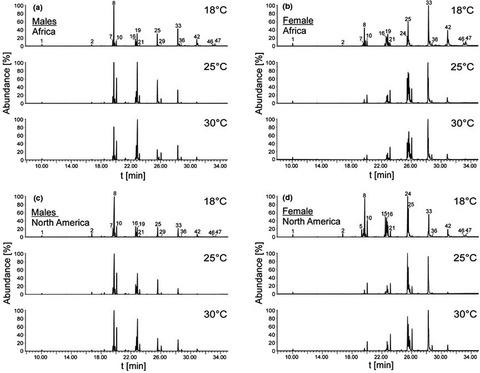当前位置:
X-MOL 学术
›
Ecol. Evol.
›
论文详情
Our official English website, www.x-mol.net, welcomes your
feedback! (Note: you will need to create a separate account there.)
Post‐eclosion temperature effects on insect cuticular hydrocarbon profiles
Ecology and Evolution ( IF 2.3 ) Pub Date : 2020-12-07 , DOI: 10.1002/ece3.7050 Subhash Rajpurohit 1, 2 , Vladimír Vrkoslav 3 , Robert Hanus 3 , Allen G Gibbs 4 , Josef Cvačka 3 , Paul S Schmidt 2
Ecology and Evolution ( IF 2.3 ) Pub Date : 2020-12-07 , DOI: 10.1002/ece3.7050 Subhash Rajpurohit 1, 2 , Vladimír Vrkoslav 3 , Robert Hanus 3 , Allen G Gibbs 4 , Josef Cvačka 3 , Paul S Schmidt 2
Affiliation

|
The insect cuticle is the interface between internal homeostasis and the often harsh external environment. Cuticular hydrocarbons (CHCs) are key constituents of this hard cuticle and are associated with a variety of functions including stress response and communication. CHC production and deposition on the insect cuticle vary among natural populations and are affected by developmental temperature; however, little is known about CHC plasticity in response to the environment experienced following eclosion, during which time the insect cuticle undergoes several crucial changes. We targeted this crucial to important phase and studied post‐eclosion temperature effects on CHC profiles in two natural populations of Drosophila melanogaster. A forty‐eight hour post‐eclosion exposure to three different temperatures (18, 25, and 30°C) significantly affected CHCs in both ancestral African and more recently derived North American populations of D. melanogaster. A clear shift from shorter to longer CHCs chain length was observed with increasing temperature, and the effects of post‐eclosion temperature varied across populations and between sexes. The quantitative differences in CHCs were associated with variation in desiccation tolerance among populations. Surprisingly, we did not detect any significant differences in water loss rate between African and North American populations. Overall, our results demonstrate strong genetic and plasticity effects in CHC profiles in response to environmental temperatures experienced at the adult stage as well as associations with desiccation tolerance, which is crucial in understanding holometabolan responses to stress.
中文翻译:

羽化后温度对昆虫表皮碳氢化合物分布的影响
昆虫角质层是内部稳态与恶劣的外部环境之间的界面。角质层碳氢化合物 (CHC) 是这种硬质角质层的关键成分,与压力反应和交流等多种功能相关。 CHC 的产生和在昆虫角质层上的沉积因自然种群而异,并受发育温度的影响;然而,对于CHC对羽化后经历的环境的可塑性知之甚少,在此期间,昆虫角质层经历了几个关键的变化。我们针对这一关键阶段,研究了羽化后温度对两个黑腹果蝇自然种群 CHC 分布的影响。羽化后 48 小时暴露于三种不同温度(18°C、25°C 和 30°C)对黑腹果蝇祖先非洲种群和最近衍生的北美种群的 CHC 产生了显着影响。随着温度的升高,观察到 CHC 链长度从较短到较长的明显转变,并且羽化后温度的影响因种群和性别而异。 CHC 的数量差异与人群之间干燥耐受性的变化有关。令人惊讶的是,我们没有发现非洲和北美人口的失水率有任何显着差异。总体而言,我们的结果表明,CHC 谱对成年阶段经历的环境温度的强烈遗传和可塑性影响以及与干燥耐受性的相关性,这对于理解全代谢对压力的反应至关重要。
更新日期:2021-01-08
中文翻译:

羽化后温度对昆虫表皮碳氢化合物分布的影响
昆虫角质层是内部稳态与恶劣的外部环境之间的界面。角质层碳氢化合物 (CHC) 是这种硬质角质层的关键成分,与压力反应和交流等多种功能相关。 CHC 的产生和在昆虫角质层上的沉积因自然种群而异,并受发育温度的影响;然而,对于CHC对羽化后经历的环境的可塑性知之甚少,在此期间,昆虫角质层经历了几个关键的变化。我们针对这一关键阶段,研究了羽化后温度对两个黑腹果蝇自然种群 CHC 分布的影响。羽化后 48 小时暴露于三种不同温度(18°C、25°C 和 30°C)对黑腹果蝇祖先非洲种群和最近衍生的北美种群的 CHC 产生了显着影响。随着温度的升高,观察到 CHC 链长度从较短到较长的明显转变,并且羽化后温度的影响因种群和性别而异。 CHC 的数量差异与人群之间干燥耐受性的变化有关。令人惊讶的是,我们没有发现非洲和北美人口的失水率有任何显着差异。总体而言,我们的结果表明,CHC 谱对成年阶段经历的环境温度的强烈遗传和可塑性影响以及与干燥耐受性的相关性,这对于理解全代谢对压力的反应至关重要。











































 京公网安备 11010802027423号
京公网安备 11010802027423号